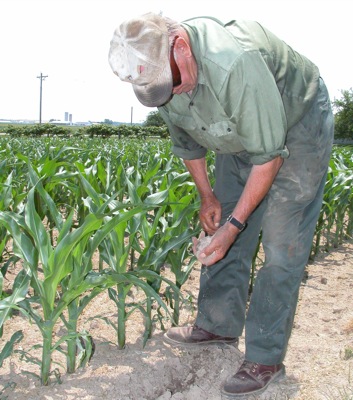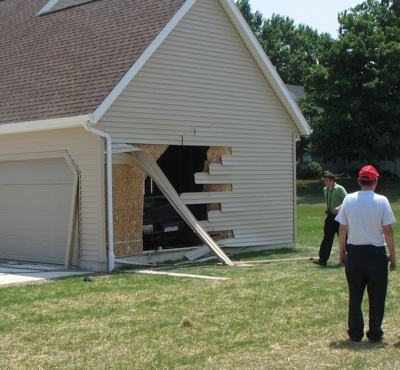Friday, June 15th, 2007
A few raindrops shy of a drought
By Shelley Grieshop

Photo by Shelley Grieshop/The Daily Standard
Retired farmer Louis Walterbusch sifts through the dry dirt of his son's cornfield along Coldwater Creek Road near Coldwater. Although he and other farmers are concerned about the current lack of rain, he believes it's too early to tell whether it will have an impact at harvest time, he said.
The leaves on the shin-high stalks of corn have begun to curl in the sweltering heat of early summer in the Grand Lake area.
It's dry, "abnormally dry," as weather experts across the United States have classified Ohio's current status. And that's a stone's throw away from the big "D" word that farmers don't want to think about just yet: drought.
"Our corn ain't been suffering too much so far, but we need rain soon," said Louis Walterbusch, a retired farmer who helps out on his son's farm east of Coldwater.
Walterbusch, 83, said he's talked with other farmers in the area and in Indiana and rain has been spotty and sparse everywhere, he said.
"About 10 days ago we got about an inch out here, but we need more ... now," he said.
The forecast from the National Weather Service (NWS) calls for a 30 percent chance of rain Tuesday, but Meteorologist Steve Hrebenach isn't making any promises.
"That's pretty far out there," he said of the stretching five-day forecast.
This is the ninth day locally without rain and with consistent highs in the 80s and 90s, according to Dennis and Theresa Howick of rural Celina, who gather weather statistics for the NWS. The average rainfall for May is 3.64 inches; the area saw just 1.15 last month. June's normal range is 3.86 inches but just a trace - 0.22 - has hit the ground so far.
"The shortage of rain is bad enough, but the temperatures are running above average, too," Theresa Howick said.
The U.S. Drought Monitor, an organization that partners with the U.S. Department of Agriculture, combines state-of-the-art science with subjectivity from numerous sources to make determinations of drought. The agency's most recent evaluation, released Thursday, indicates the Grand Lake area is "going into a drought." The impact of the situation includes stunted crop growth and fire risks.
A drought is defined by scientists at the Drought Monitor as "a moisture deficit bad enough to have social, environmental or economic effects."
No single definition of drought works for all circumstances, experts say. A drought is declared by physical observations of agricultural effects on crops, pastures and grasslands and effects on water supplies such as rivers, groundwater and reservoirs.
The driest year recorded locally was in 1988. During that year, between May 25 and July 10, there were 19 days without a single drop of rain. From March to October in 1988 just 18.83 inches of rain fell, which was 8.14 inches below average.
"The corn wasn't coming up that year and many people replanted," Walterbusch said as he recalled the summer nearly 20 years ago. "Then in July we got 3 inches, and it turned out to be a pretty good crop."
Unfortunately, the current weather conditions may be here to stay. The Climate Prediction Center, which also partners with the NWS and the Drought Monitor, predicts a warmer than normal summer with below median precipitation for most of the United States, including Ohio.


